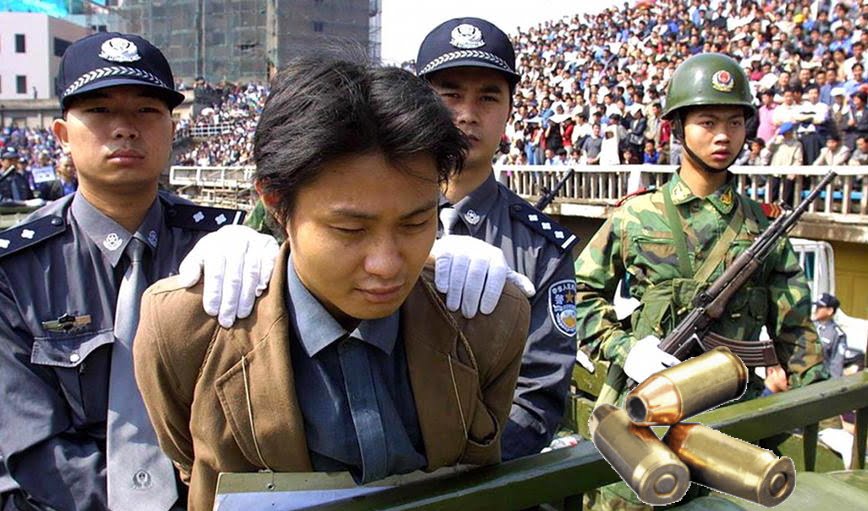According to widespread information, relatives of Chinese residents sentenced to death by firing squad receive a bill equivalent to the cost of one or two bullets. We checked if this is true.
Stories about the harshness of the judicial system in China have long become legendary. Often, such stories report a penny bill for a bullet, which supposedly comes to the family of an executed person. Here's what he writes about it: “Kommersant": “As a rule, countries do not disclose the cost of capital punishment. However, we are talking about significant costs. By the way, China has found a way out of the situation. There, the execution of the sentence is paid for by the relatives of the convicted. Moreover, they are sent an invoice for the used bullets by mail.”
"Echo of Moscow” (2009) adds some details: “It is curious that the property of corrupt officials in China is confiscated, and the family is sent by mail a bill for 8 yuan, about 36 rubles. That’s a two-shot count.”
But "Arguments and facts"(2009) and Ekaterinburg"Regional newspaper”(2021) they even name specific victims: “Even the vice mayor of Beijing, Liu Zhihua, who received a bribe of $2 million, was sentenced to death” and “... a bill of 8 yuan (93.5 rubles) for two bullets with which he was shot. Just last week, a court in Tianjin executed the former chairman of the state-owned asset management company China Huarong, Lai Xiaomin...”
But most of all outside of China (and in the Celestial Empire itself) it is known Lin Zhao's story - a 36-year-old poetess executed in 1968 for criticizing Mao Zedong and the party line. It is noted that Lin's family did not know about her death until an official collected payment from her mother for the bullet used in the execution.
It should be noted that China has an extremely closed policy of reporting on the prison system, and there are no official details about such a fee today (if it is practiced). Moreover, attempts users to find out details from Chinese residents were unsuccessful - over several years, the majority of respondents on the Quora website either did not know about this practice or denied it. Some generally questioned the identity of dissident Lin Zhao, others noted that with the current quantity executions (from 6,500 in 2007 to 2,400 in 2013, some of them through lethal injection), the cost of a bullet of several tens of cents does not constitute at least a noticeable column in the budget for the state and their compensation is illogical. They say that then they would have to charge for food for the convicts, because these are much more tangible figures.
Nevertheless, it is difficult to hide the stories of specific people, in particular, information about the fate of Lin Zhao, a cult figure for modern China. A Christian woman who, even in prison - with blood - continued to write texts denouncing Mao, was posthumously rehabilitated in 1981. And although the authorities to this day keep the circumstances of her case classified as “secret”, since the moment of her rehabilitation many details have leaked to the light. As it turned out, on the afternoon of May 1, 1968, a policeman entered the house where Lin Zhao’s mother and sister lived. He reported that the prisoner had been executed and demanded that the costs be paid in the amount of 5 fen (that is, 0.05 yuan). Relatives later learned that the execution took place on April 29. In 2005, the author’s film “In Search of Lin Zhao’s Soul” was released, which included audio recording the story of the martyr's sister about this.
From another source, a biographical study of Xi Lian "Bloody letters"(Duke University, USA, 2018), you can find out about Lin Zhao’s own attitude towards such practices (it turns out that the activist was not its first victim). In particular, in 1965, a brave woman wrote a letter to the editor of the main Chinese newspaper, People's Daily. She called the price of the bullet quite low, and the execution itself “an easy way to die and bleed in front of people in broad daylight.” It also says that collecting debt for a bullet during the Cultural Revolution in China was of great importance for the revolutionaries. In particular, examples of similar actions are given in relation to other residents of Shanghai - a counter-revolutionary Liu Weinhui (March 1967) and conductor of the local symphony orchestra Liu Honggen (April 1968). Moreover, information about such a norm was confirmed by a person who worked as a guard in the Shanghai Tilanqiao prison, where Lin Zhao was kept. They denied the fact of collection only in the Supreme People's Court of Shanghai (where the verdict was pronounced), but they could not vouch for the actions of other services, in particular the local police.
So, we can say that compensation for the cost of an execution bullet was common in China during the Cultural Revolution (1966-1976). But it is interesting to know how things were later - from the 1980s to the present day. But the practice, it turns out, continued. In 1987, the newspaper Los Angeles Times even cited a new tariff for an execution bullet - 27 fenes.
In a report by the well-known human rights organization Human Rights Watch for August 1994 it was saidthat the organs of executed people are often used for transplantation without the consent of the owners and their closest relatives. In some cases, relatives receive an offer from the state to donate organs for transplantation for a special fee (from hundreds to thousands of yuan), but if they refuse, they are presented with a huge bill for all expenses, “including food, maintenance, cremation and even a bullet (about 6 cents).”
Next, it is necessary to highlight an important milestone. After China passed a law on lethal injection as a voluntary alternative to the bullet in 1997, many convicts began to choose the first option - painless and quick. Therefore, the practice of executions itself began to lose its spread. At the same time, another authoritative human rights organization Amnesty International noted, that only a small share of statistics on executions becomes public knowledge - the rest of the cases are kept secret.
November 28, 2006 was executed Chen Tao is a participant in popular protests in Sichuan province who was accused of intentionally killing a police officer. As many have written sources, the father of the executed man was then presented with a bill of 50 yuan (about $6). News sites and forums provide several more names of victims of the “bullet count” in the 2000s.
In 2009, Chinese newspapers wrotethat the government would cover 700 yuan (about $95) for each execution, with lethal injection being provided free of charge to the Higher People's Courts. IN book The 2010 “Death Penalty in China: History, Legislation and Current Practice” says nothing about the bullet count, but notes that lethal injection was already the dominant of the two possible methods of execution at that time. Both information suggests that the “bullet count” was rarely used at that time.
And indeed, if you look at the sources of recent years, this point of view is confirmed. In 2020, the fact that the practice is a thing of the past was noted by a popular Chinese portal 163.com. This was confirmed by other sources 2016 And 2018 years.
Thus, with a high degree of probability it can be said that at present the practice of billing for execution bullets is not widespread in China. At the same time, it existed at the beginning of the 21st century.
Half-truth
Read on topic:
1. Hu Jie. “In Search of Lin Zhao's Soul"
If you find a spelling or grammatical error, please let us know by highlighting the error text and clicking Ctrl+Enter.







